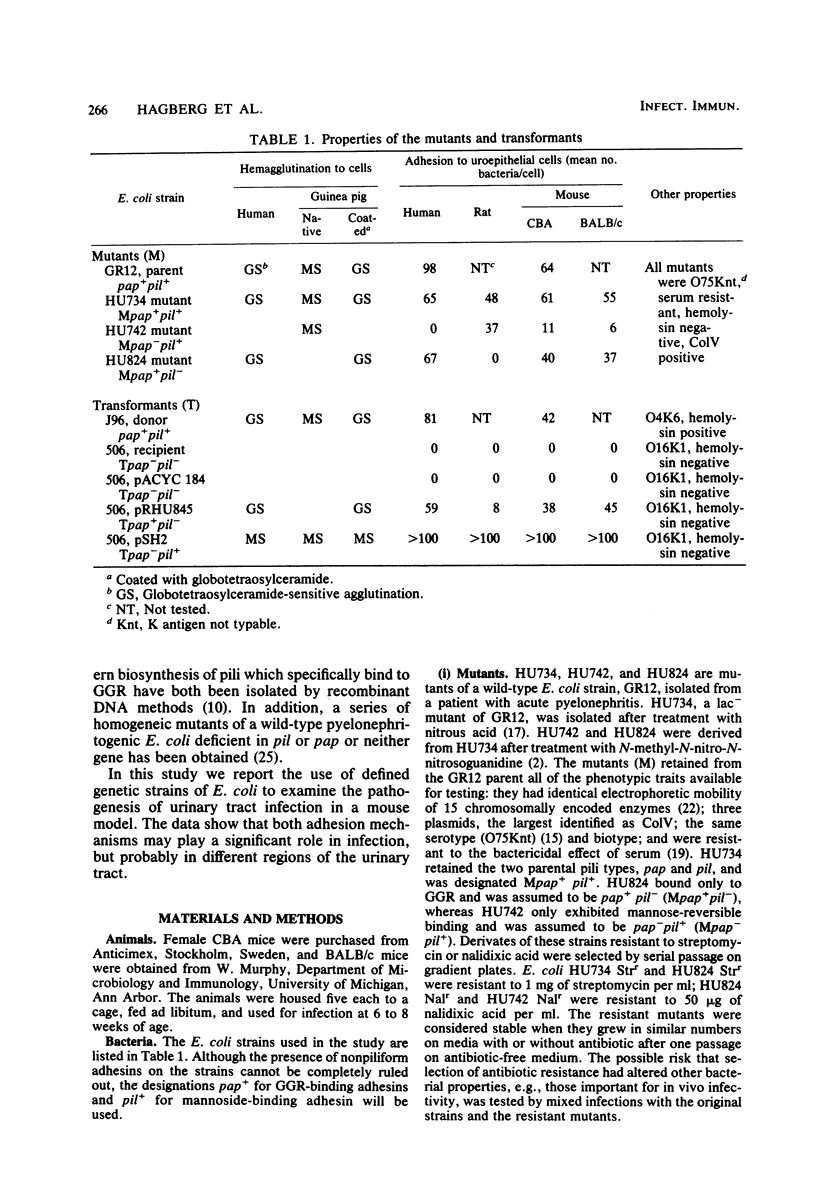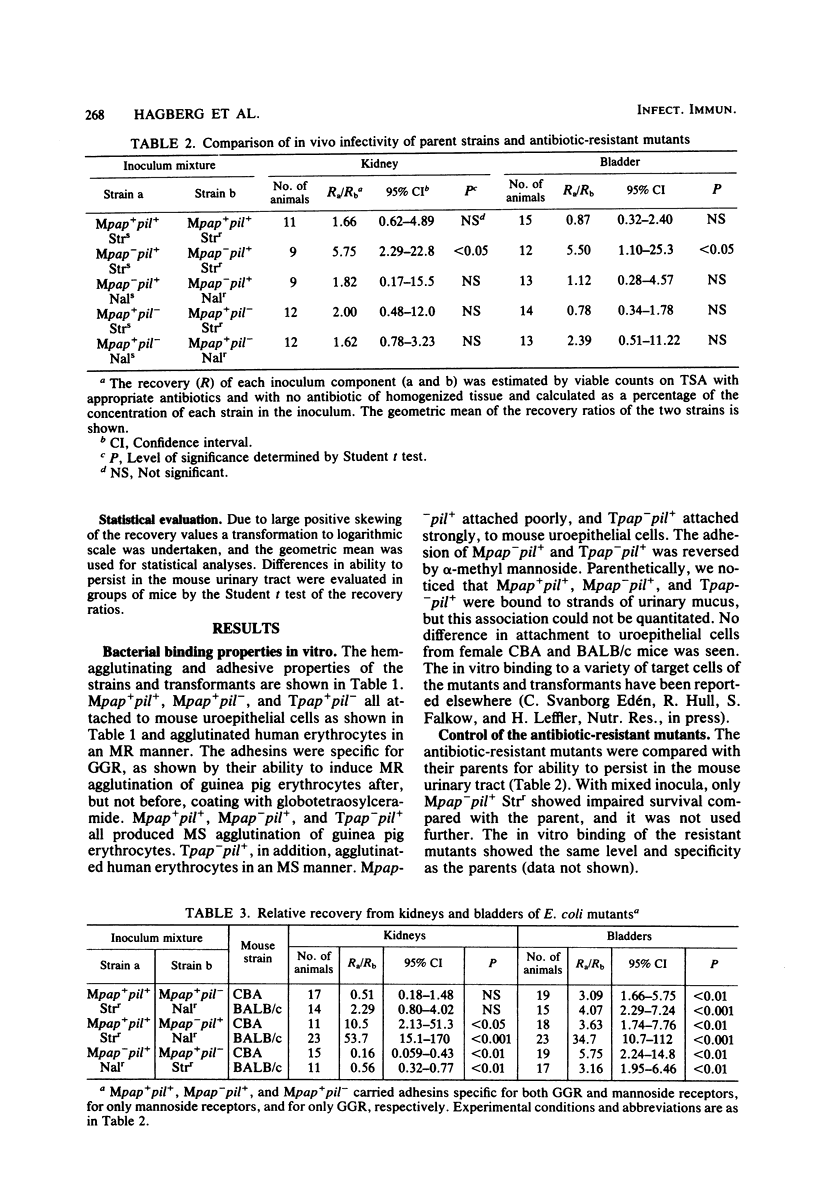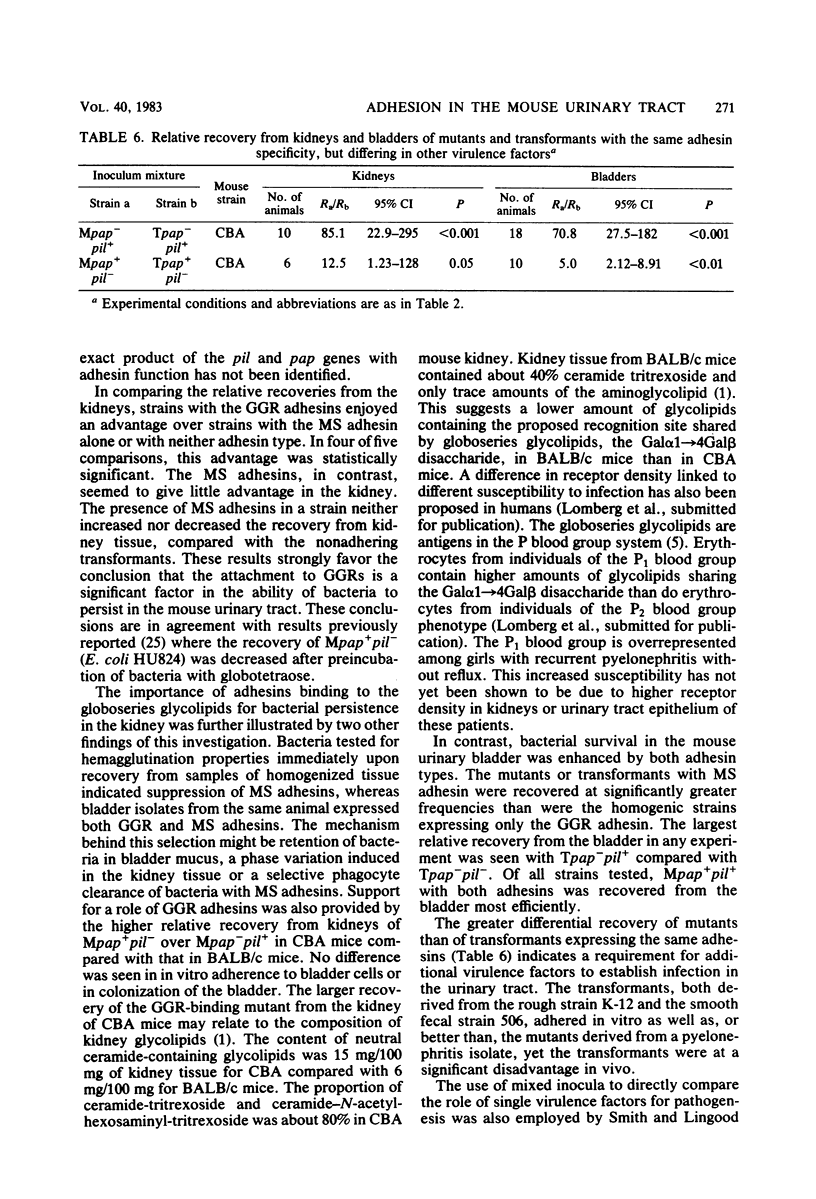Abstract
The affinity of uropathogenic Escherichia coli to kidneys and bladders of experimentally infected mice was shown to be determined in part by the adhesive properties of the infecting bacteria. Mice were infected with various pairwise combinations of two homogeneic sets of bacteria: (i) mutants derived from a human pyelonephritis E. coli isolate which were selected to express either or both adhesins specific for globoseries glycolipid receptors or for “mannosides”; and (ii) transformants of a normal fecal isolate which harbored recombinant plasmids encoding the genes for one or the other adhesin or which harbored only the vector plasmid. The relative efficiency of survival of the strains to be compared was evaluated in each animal by plating on selective media of samples of homogenized kidneys and bladders taken 24 h after intravesical inoculation. The presence of adhesins specific for globoseries glycolipid receptors, which mediate the in vitro mannose-resistant attachment to human and mouse uroepithelial cells, enhanced bacterial recovery from both kidneys and bladders of infected animals. The addition to the infecting strain of adhesins binding mannoside residues further improved bacterial recovery from the bladder, but not from the kidney. The mutants and transformants with adhesins binding only mannosides were recovered in higher numbers from the bladder than those expressing adhesins specific for the globoseries glycolipids only. There was apparent selection in vivo decreasing expression of mannoside binding adhesins in the kidneys, but not in the bladders, of animals infected with the mutant expressing both types of adhesins. Regardless of adhesive properties, the mutants of the pyelonephritis isolate were recovered in significantly higher numbers than the fecal isolate with adhesins encoded on recombinant plasmids. We conclude that the adhesive properties in part determine the localization and retention of bacteria in the mouse urinary tract. However, the addition of adhesins to a commensal E. coli strain was not sufficient to confer colonization capacity comparable to that of a pyelonephritis strain.
Full text
PDF







Selected References
These references are in PubMed. This may not be the complete list of references from this article.
- Adams E. P., Gray G. M. The carbohydrate structures of the neutral ceramide glycolipids in kidneys of different mouse strains with special reference to the ceramide dihexosides. Chem Phys Lipids. 1968 Jun;2(2):147–155. doi: 10.1016/0009-3084(68)90018-2. [DOI] [PubMed] [Google Scholar]
- Beachey E. H. Bacterial adherence: adhesin-receptor interactions mediating the attachment of bacteria to mucosal surface. J Infect Dis. 1981 Mar;143(3):325–345. doi: 10.1093/infdis/143.3.325. [DOI] [PubMed] [Google Scholar]
- Chang A. C., Cohen S. N. Construction and characterization of amplifiable multicopy DNA cloning vehicles derived from the P15A cryptic miniplasmid. J Bacteriol. 1978 Jun;134(3):1141–1156. doi: 10.1128/jb.134.3.1141-1156.1978. [DOI] [PMC free article] [PubMed] [Google Scholar]
- Eden C. S., Eriksson B., Hanson L. A. Adhesion of Escherichia coli to human uroepithelial cells in vitro. Infect Immun. 1977 Dec;18(3):767–774. doi: 10.1128/iai.18.3.767-774.1977. [DOI] [PMC free article] [PubMed] [Google Scholar]
- Edén C. S., Freter R., Hagberg L., Hull R., Hull S., Leffler H., Schoolnik G. Inhibition of experimental ascending urinary tract infection by an epithelial cell-surface receptor analogue. Nature. 1982 Aug 5;298(5874):560–562. doi: 10.1038/298560a0. [DOI] [PubMed] [Google Scholar]
- Edén C. S., Hagberg L., Hanson L. A., Korhonen T., Leffler H., Olling S. Adhesion of Escherichia coli in urinary tract infection. Ciba Found Symp. 1981;80:161–187. doi: 10.1002/9780470720639.ch11. [DOI] [PubMed] [Google Scholar]
- Fletcher K. S., Bremer E. G., Schwarting G. A. P blood group regulation of glycosphingolipid levels in human erythrocytes. J Biol Chem. 1979 Nov 25;254(22):11196–11198. [PubMed] [Google Scholar]
- Freter R. Mechanisms of association of bacteria with mucosal surfaces. Ciba Found Symp. 1981;80:36–55. doi: 10.1002/9780470720639.ch4. [DOI] [PubMed] [Google Scholar]
- Hagberg L., Engberg I., Freter R., Lam J., Olling S., Svanborg Edén C. Ascending, unobstructed urinary tract infection in mice caused by pyelonephritogenic Escherichia coli of human origin. Infect Immun. 1983 Apr;40(1):273–283. doi: 10.1128/iai.40.1.273-283.1983. [DOI] [PMC free article] [PubMed] [Google Scholar]
- Hagberg L., Jodal U., Korhonen T. K., Lidin-Janson G., Lindberg U., Svanborg Edén C. Adhesion, hemagglutination, and virulence of Escherichia coli causing urinary tract infections. Infect Immun. 1981 Feb;31(2):564–570. doi: 10.1128/iai.31.2.564-570.1981. [DOI] [PMC free article] [PubMed] [Google Scholar]
- Hull R. A., Gill R. E., Hsu P., Minshew B. H., Falkow S. Construction and expression of recombinant plasmids encoding type 1 or D-mannose-resistant pili from a urinary tract infection Escherichia coli isolate. Infect Immun. 1981 Sep;33(3):933–938. doi: 10.1128/iai.33.3.933-938.1981. [DOI] [PMC free article] [PubMed] [Google Scholar]
- Lidin-Janson G., Hanson L. A., Kaijser B., Lincoln K., Lindberg U., Olling S., Wedel H. Comparison of Escherichia coli from bacteriuric patients with those from feces of healthy schoolchildren. J Infect Dis. 1977 Sep;136(3):346–353. doi: 10.1093/infdis/136.3.346. [DOI] [PubMed] [Google Scholar]
- MEYNELL G. G. The applicability of the hypothesis of independent action to fatal infections in mice given Salmonella typhimurium by mouth. J Gen Microbiol. 1957 Apr;16(2):396–404. doi: 10.1099/00221287-16-2-396. [DOI] [PubMed] [Google Scholar]
- Minshew B. H., Jorgensen J., Counts G. W., Falkow S. Association of hemolysin production, hemagglutination of human erythrocytes, and virulence for chicken embryos of extraintestinal Escherichia coli isolates. Infect Immun. 1978 Apr;20(1):50–54. doi: 10.1128/iai.20.1.50-54.1978. [DOI] [PMC free article] [PubMed] [Google Scholar]
- Olling S., Hanson L. A., Holmgren J., Jodal U., Lincoln K., Lindberg U. The bactericidal effect of normal human serum on E. coli strains from normals and from patients with urinary tract infections. Infection. 1973;1(1):24–28. doi: 10.1007/BF01638251. [DOI] [PubMed] [Google Scholar]
- Orskov I., Orskov F., Birch-Andersen A. Comparison of Escherichia coli fimbrial antigen F7 with type 1 fimbriae. Infect Immun. 1980 Feb;27(2):657–666. doi: 10.1128/iai.27.2.657-666.1980. [DOI] [PMC free article] [PubMed] [Google Scholar]
- Salit I. E., Gotschlich E. C. Type I Escherichia coli pili: characterization of binding to monkey kidney cells. J Exp Med. 1977 Nov 1;146(5):1182–1194. doi: 10.1084/jem.146.5.1182. [DOI] [PMC free article] [PubMed] [Google Scholar]
- Selander R. K., Levin B. R. Genetic diversity and structure in Escherichia coli populations. Science. 1980 Oct 31;210(4469):545–547. doi: 10.1126/science.6999623. [DOI] [PubMed] [Google Scholar]
- Smith H. W., Linggood M. A. Observations on the pathogenic properties of the K88, Hly and Ent plasmids of Escherichia coli with particular reference to porcine diarrhoea. J Med Microbiol. 1971 Nov;4(4):467–485. doi: 10.1099/00222615-4-4-467. [DOI] [PubMed] [Google Scholar]
- Svanborg Edén C., Gotschlich E. C., Korhonen T. K., Leffler H., Schoolnik G. Aspects on structure and function of pili on uropathogenic Escherichia coli. Prog Allergy. 1983;33:189–202. doi: 10.1159/000318330. [DOI] [PubMed] [Google Scholar]
- Swaney L. M., Liu Y. P., Ippen-Ihler K., Brinton C. C., Jr Genetic complementation analysis of Escherichia coli type 1 somatic pilus mutants. J Bacteriol. 1977 Apr;130(1):506–511. doi: 10.1128/jb.130.1.506-511.1977. [DOI] [PMC free article] [PubMed] [Google Scholar]


